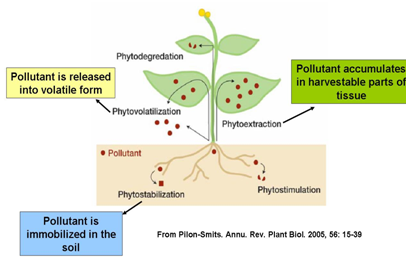ENVIS Centre, Ministry of Environment & Forest, Govt. of India
Printed Date: Sunday, August 31, 2025
Phytoremediation - Use of Green Plants to Remove Pollutants
Source:http://rydberg.biology.colostate.edu/Phytoremediation/2008%20websites/
BZ572_Radionuclides%20website_Tom%20Grant/UGA_phyto_fig.jpg
Phytoremediation is defined as the use of green plants to remove pollutants from the environment or render them harmless. This cost-effective plant-based approach to remediation takes advantage of the remarkable ability of plants to concentrate elements and compounds from the environment and to metabolize various molecules in their tissues. Toxic heavy metals and organic pollutants are the major targets for phytoremediation. Phyto-(or green-plant based-) remediation is not a new concept. About 300 years ago, plants were proposed for use in the treatment of wastewater. Thlaspi caerulescens and Viola calaminaria were the first plant species documented to accumulate high levels of metals in leaves.
Phytoremediation can be divided into the following areas:

- Phytoextraction: In this process, pollutant-accumulating plants are used to remove metals or organics from soils by concentrating them in the harvestable parts.
- Phytodegradation: This is the use of plats and associated microorganisms to degrade organic pollutants, including ammunition wastes (e.g. TNT and GTN), polychlorinated phenols (PCBs), and tricholoethylene (TCE). Successful phytodegradation requires organic contaminants to be biologically available for absorption to, or uptake and metabolism by, plant or plant-associated microbial systems. Bioavailability depends on the relative lipophilcity of the compound, the soil type, and the age of the contaminant.
- Rhizofilteration: This is the use of plant roots to absorb and adsorb pollutants, mainly metals, from water and aqueous waste streams. An ideal plant for rhizofilteration should have rapidly growing roots with the ability to remove toxic metals from solution over extended periods of time. A number of plants such as Indian mustard (Brassica juncea), rye, corn, sunflower have an intrinsic ability to absorb and precipitate having metals from solution.
- Phytostabilization: This is the use of plants to reduce the bioavailability of pollutants in the environment. Heavy metal polluted soils usually lack established vegetation cover due to the toxic effects of pollutants. Barren soils are more prone to erosion and leaching which spread pollutants in the environment.
- Phytovolatilization: This is the use of plants to volatilize pollutants. Phytovolatilization of metals may have unique advantages over phytoextraction, because it bypasses harvesting and disposal of metal rich biomass.
Advantages of Phytoremediation:
Plants are solar-driven pumping and filtering systems that have measurable loading, degrading and fouling capacities. Similarly, root may be described as exploratory, liquid-phase extractors that can find, alter and/or translocate elements and compounds against large chemical gradients. Therefore, plants can also be a cost-effective alternative to physical remediation systems.
Limits of Phytoremediation:
As plants are alive, their root require oxygen, water and nutrients, soil texture, pH, salinity, pollutants concentrations and the presence of other toxins must be within the limits of plant tolerance. Contaminants that are highly water soluble may leach outside the root zone and require containment. Phytoremediation is also frequently slower than physio-chemical process, may need to be considered as long-term remediation process.
List of some plants used in phytoremediation
|
Plant
|
Metal
|
Method of Phytoremediation
|
|
Brassica juncea
|
Lead
|
Chelate-assisted phytoextraction
|
|
Thlaspi caerulescens
|
Cadmium
|
Continuous phytoextraction
|
|
Silense vulgaris
|
Zinc
|
Continuous phytoextraction
|
|
Brassica oleracea
|
Zinc
|
Continuous phytoextraction
|
|
Raphanus sativus
|
Cadmium
|
Continuous phytoextraction
|
|
Thlaspi caerulescens
|
Nickel
|
Continuous phytoextraction
|
|
Alyssum lesbiacum
|
Copper
|
Continuous phytoextraction
|
|
Alyssum murale
|
Lead
|
Continuous phytoextraction
|
|
Arabidopsis thaliana
|
Chromium
|
Continuous phytoextraction
|
|
Brassica juncea
|
Selenium
|
Continuous phytoextraction
|
|
Ipomea alpine
|
Copper
|
Continuous phytoextraction
|
|
Haumaniastrum robertii
|
Cobalt
|
Continuous phytoextraction
|
|
Sebertia acuminate
|
Nickel
|
Continuous phytoextraction
|
|
Agrotis tenuis
|
Lead
|
Phytostabilization
|
|
Festuca arundinacea
|
Boron
|
Phytovolatilization
|
|
Hibiscus cannibus
|
Boron
|
Phytovolatilization
|
|
Lotus corniculatus
|
Boron
|
Phytovolatilization
|
|
Astragalus racemosus
|
Selenium
|
Phytovolatilization
|
|
Helianthus annus
|
Uranium
|
Rhizofiltration
|
Source:http://www.biotecharticles.com/Environmental-Biotechnology-Article/Phytoremediation-Use-of-green-plants-to-remove-pollutants-704.html